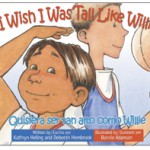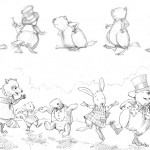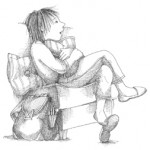When did you get started illustrating for children? What did you do before?
 I started putting together a portfolio and joined SCBWI in 2000. Before that, I was a freelance graphic (print) designer and business writer: catalogs, ad copy, brochures, newsletters, etc. I am fortunate to have had clients (a children’s dance company, a local university) whose projects gave me the nucleus of a portfolio, so I didn’t start totally from scratch.
I started putting together a portfolio and joined SCBWI in 2000. Before that, I was a freelance graphic (print) designer and business writer: catalogs, ad copy, brochures, newsletters, etc. I am fortunate to have had clients (a children’s dance company, a local university) whose projects gave me the nucleus of a portfolio, so I didn’t start totally from scratch.
Tell us a little bit about the recent books you illustrated, the I Wish for Boys, and I Wish for Girls series.


I wish I was tall like… I wish I was strong like…
The opportunity to illustrate the first two books came about because I had done two small work-for-hire jobs for Raven Tree, and so was on the list when a call went out to submit sketches on spec.


I Wish I had glasses like… I wish I had freckles like…
The “I Wish” girls’ books were released simultaneously, as companion books from the point of view of each of the two best friends. Each admires something about the other: one thinks her friend’s glasses are cool, and wishes she wore glasses, too; the other thinks having freckles like her friend would be really neat. When the books did well, Raven Tree asked the authors to write a companion set for boys as well.
I understand these books repeat characters across the series. What was the first book? How do you work at making a previously secondary character become the main character? Are there more books planned?
The two girls and the two boys were costars — we made sure each had equal “face time,” so neither was ever really secondary within their respective sets. There was a bit of a subtle crossover from the girls’ books to the boys’: one of the girls’ books mentions “a neighbor’s dog.” The dog shows up in the boys’ books as belonging to one of the main characters—and there’s a scene at school in one of the boys’ books where you can see the two girls, Abby and Rosa, in the background. So the illustrations imply that they all know each other.
I haven’t heard of plans to continue the series, but they are all being re-released in English-only editions (the originals were bilingual).
These books are not typical picture books. How do they differ from other books in the genre?
In general, you don’t worry about reading level in a picture book, because most are meant to be read by an adult, to a child. But because these books were originally planned as bilingual books, they have potential for use as teaching tools, for both English-speaking and Spanish-speaking children (and adults, as well—picture books are often used in adult ESL programs). So not only does the text have to be carefully planned to conform to a reading level (second grade, in this case), but the illustrations must support the text more literally than would perhaps be usual. Readers are looking for clues in the pictures: if the text mentions finding a ball under a bed, the illustration must show a ball under a bed.
Otherwise, the format is the same.
What are you working on right now? Do you have any other books or art projects you’d like to talk about?
I’m finishing up illustrations for another picture book from Raven Tree: Bedtime Monster, by Heather Ayris Burnell. This book will also be released in both bilingual and English-only editions.
Do you do non-children’s book art (licensing, fine art, etc.) or art just for fun? Is that art similar or different from your children’s book art?
No, I wouldn’t say I do art just for fun. I do have a good bit of non-commissioned work, but all are done specifically as portfolio pieces. My background is in art for print; I’ve never given much thought to archival issues, for instance. But I understand that Raven Tree has entered into an agreement with a gallery to sell original art from their books, so in order to be on board, I’m having to rethink how I approach the art for this current book. I need to be more aware of maintaining viable, archive-quality originals.
Do you illustrate full time? If not, what else do you do?
I write, as well. My “magnum opus” is a middle grade historical, which was hugely satisfying to work on. I also have a couple of clients from my freelance days who have stuck with me, so I still do some graphic work, although I’m not actively pursuing design work outside of children’s publishing now.
When you illustrate a picture book how do you decide what scenes and details to draw?
I start by story boarding thumbnails. A good picture book is written in scenes, so it’s not so much a question of choosing which scenes as of figuring out the emphasis within a scene. It helps me to think cinematically: where would the camera be positioned, and is it a close-up, or a wide-angle shot?
I prefer vignette illustration without much background (when I can get away with it!), probably because of my experience doing spot illustrations for magazines, etc.
When illustrating picture books do you include a visual storyline not mentioned by the text or include animals or people you know?
The illustrations for the Raven Tree books enlarge on the text, but do not carry a specific subtext. I gave both boys dogs, which weren’t in the text, simply as a way of livening up the illustrations.
It’s always fun to throw in something personal. The crossover dog I mentioned from the “I Wish” series is my much loved and recently departed golden retriever. I was able to work her into Bedtime Monster, too—as the cover illustration on a book in the main character’s bedroom.
And, of course, I see a little bit of my two daughters in all my characters.
Can you explain your art process?

I’m a sketcher. I obsess over the line work, and truthfully would be happy to stop there. I long ago fell in love with 2B lead on Bienfang parchment paper, and am thrilled that I can preserve the line quality by scanning, since that’s hardly a stable medium. Since I like to draw very tightly and use the drawing as a blueprint for the looser painting to follow, the drawing stage takes up most of my time.
You can see more work on my website: http://www.bonnieadamson.net.
Do you have a favorite color or palette?
Besides b/w line, I’m very loyal to cobalt blue, phthalo blue, Hooker’s green and sap green; plus a “dirty palette” of burnt and raw siennas, and burnt and raw umbers that I never clean away, for hair and skin tones.
What is your favorite medium to work in? Have you always worked in this media? If not, why did you switch?
In the early days of freelancing, I had many pre-separated two-color jobs, so I had to develop a consistent style for pen & ink (early copy cameras could not pick up the subtleties in pencil line). I settled on watercolor wash as a way to introduce color, and have gradually become more comfortable with watercolor as a medium. I’m most likely to combine it with pencil, colored pencil or pen and ink (Micron pen, nowadays). I used to enjoy flat-color collage for design projects, and have recently been experimenting with vector shapes in Photoshop as a way of getting back to that collage feel.
Did you always want to be an artist when you grew up?
No, I always drew, but I never considered art as a career. I was an English major, and intended to work as a magazine editor. When I couldn’t find a job right away, I went back to school and got a second degree in graphic design, figuring that would be good collateral experience. I did end up working as a reporter for a medical business news magazine, briefly, before starting my freelance career. By that time, I was more interested in the design end. As a freelance art director, I was pretty cheap and frequently did my own art to avoid hiring an illustrator. So that’s how I ended up illustrating.
Do you use models/source pictures or do you draw from your memory/imagination?

I try not to draw directly from source materials. I remember another illustrator, talking about drawing a rooster. He said he did the research on roosters, but, in the end, he needed to draw the “rooster of the mind.” So I gather lots of images, but then don’t look at them as I draw. I’m always surprised at the details I manage to dredge up once I start drawing, and I feel that because they stand out in my mind, they’re probably the salient details needed to define whatever it is.
If you could be anything other than an artist, what would you be?
I’d love to be an image analyzer for NASA’s Jet-Propulsion Lab. That would be my little behind-the-scenes contribution to space exploration. Either that, or join the crew of the Enterprise.
What gets you through an illustration when you’re stuck for inspiration?
Trial and error. I can’t think my way through. I just keep sketching until something looks right or sparks an idea.
What book do you remember from when you were young? (list one or multiple books)
Oh, golly. I was a reader. Visually? I loved my Little Golden Book collection fiercely, was addicted to Dr. Seuss, and I think my style is still influenced by vintage Platt & Munk poster-style illustrations in some of the children’s books I inherited from my mother. I was a huge comic book fan, too.
Is there a children’s book illustrator whose work you gravitate towards in the bookstore now
I’m impressed by draftsmanship, so illustrators who use line well stand out for me: Marla Frazee and Nancy Carpenter are two that come to mind immediately. There are so many beautiful books out there.
If you could illustrate any writer’s new work, who would it be?
Me! I’d love to do the b/w interiors for my historical novel. 🙂
Who do you want to be when you ‘grow up’?
My family has heard me say I want to end my days with a pair of binoculars on a coastline somewhere, counting whales for National Geographic. Between now and then, who knows? I’m up for anything!


 RSS - Posts
RSS - Posts
Thanks for such a detailed interview, Bonnie. Best of luck with your new book.
Thank you for having me, Wendy, and for allowing me to ramble on!
Your questions helped me focus on aspects of my work I need to concentrate on. Looking forward to future interviews in your series!
Hi 🙂
Thank you for the excellent interview with Bonnie. Thank you Bonnie for sharing your process and yourself here today. I loved the artwork included in the interview. The I WISH books look great. I Wish… my children were still little and I could give the books to them. (They’re highschoolers now).
Thank you again!
Love & Best Wishes,
RKCharron
xoxo
Great interview, Wendy. I loved learning more about Bonnie and reading about her process. I am beyond thrilled that she is illustrating Bedtime Monster!
I can’t wait to see it! Best of luck to both of you.
Thanks Wendy,
I enjoy Bonnie’s work. Very interesting interview.
Kit Grady
Thanks for visiting my blog, Kit. I’m glad you enjoyed the interview.
What a great interview! Really enjoyed this & found myself inspired to work harder toward my goals. Thanks Wendy for sharing & thanks Bonnie for inspiring us!